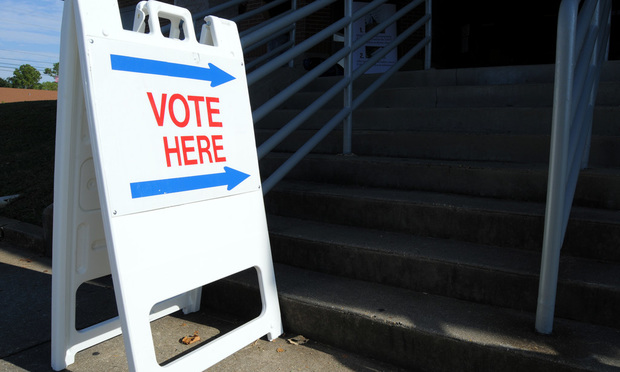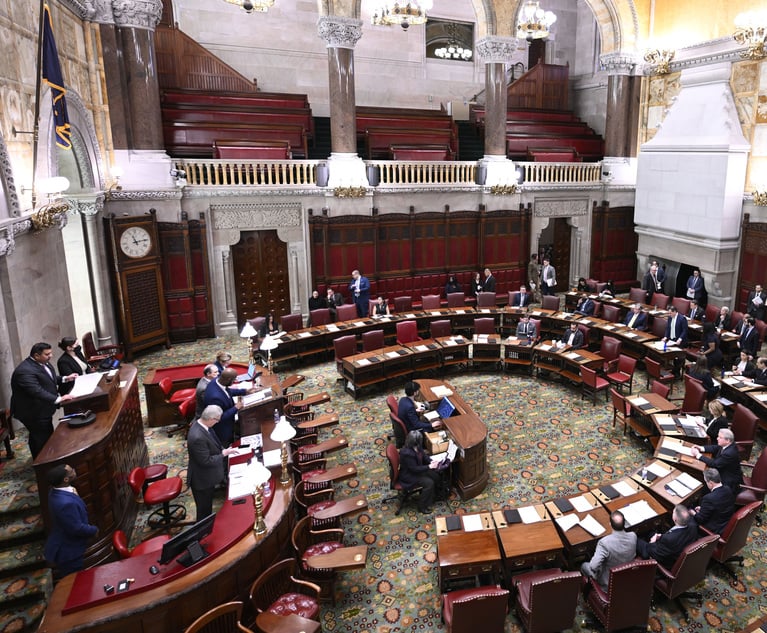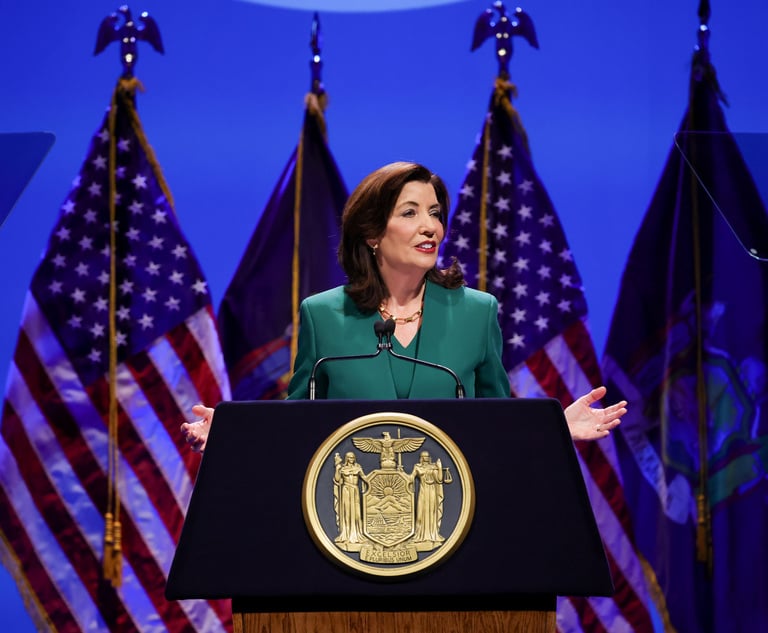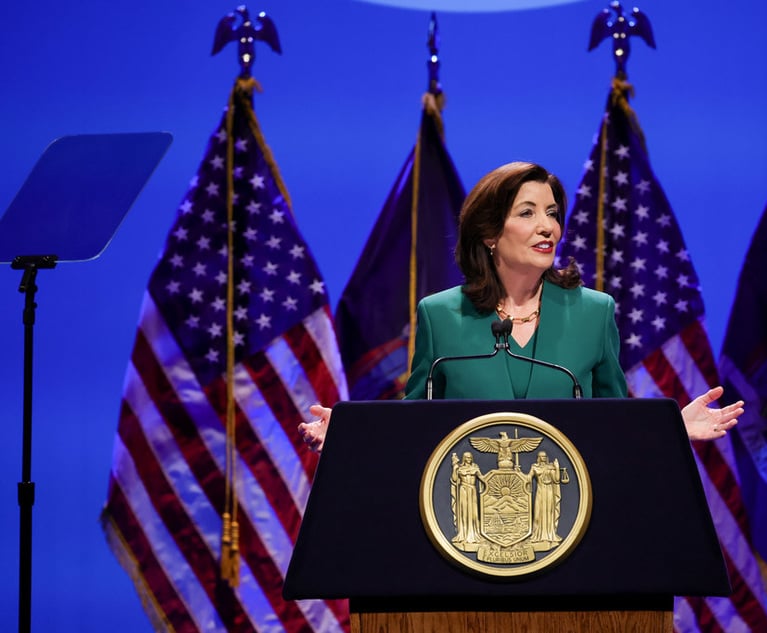Reforming New York Government: It's Time for Automatic Voter Registration
Our state government should be making it easier, not harder, for its citizens to engage.
December 21, 2018 at 02:30 PM
12 minute read

For those people keeping track of the health of our participatory democracy, last month's midterm elections received a relatively good checkup. Voter turnout was the highest in 26 midterm cycles—in other words, since 1914. S. Erdem Aytaç & Susan Stokes, Americans just set a turnout record for the midterms, voting at the highest rate since 1914. This explains why, Wash. Post (Nov. 20, 2018).
But it was not a banner year for New York.
While the national voter turnout was about 50 percent, only 42.1 percent of New York's eligible voters cast a ballot. 2018 November General Election Turnout Rates, U.S. Election Project (Dec. 4, 2018). That means that New York's voter turnout was an embarrassing 48th out of 50 states this year. Id. Third from the bottom is not where the Empire State should aspire to be.
The midterms showed, yet again, that states with reduced barriers to voting have higher turnout. It is no accident that the top eight states for turnout this year all have implemented either same-day voter registration (Maine, Minnesota, Montana, North Dakota, and Wisconsin), voting by mail (Colorado, Oregon, and Washington), or automatic voter registration (Colorado and Oregon). What is Same Day Registration? Where is it Available? Demos (2014); All-Mail Elections (a/k/a Vote-By-Mail), Nat'l Conf. of State Legislatures (2018); AVR History & Implementation Dates, Brennan Ctr. for Just. (Nov. 7, 2018); 2018 November General Election Turnout Rates. In 2018, these eight states had an average turnout of 61.3 percent, compared to an average of 49.7 percent across all other states. 2018 November General Election Turnout Rates. New York's turnout rate was more than 19 percentage points lower than this group of states with lower obstacles to voting. It is time for New York to enact automatic voter registration and other measures to remove major barriers to the democratic participation of its citizens.
New York's current voting procedures are burdensome to citizens even before they set foot in a polling place. The registration deadline is 25 days before the election, long before the logistics of voting are at the top of many New Yorkers' minds. N.Y. Election Law § 5-210 (Consol. 2018). For those who do register before the deadline, New York offers little flexibility on the timing and location of voting: It remains one of only 12 states that do not offer no-excuse early voting. Absentee and Early Voting, Nat'l Conf. of State Legislatures (2018). Thus, many potential New York voters face the choice between waiting in line to vote during business hours on a weekday or not voting at all. This year, nearly three out of every five eligible New Yorkers did not vote. 2018 November General Election Turnout Rates.
Voting in the United States was not always this difficult—and accordingly, turnout was not nearly this low. In fact, before the implementation of voter registration requirements in the late 1800s and early 1900s, national voter turnout in presidential election years occasionally topped 80 percent and rarely fell below 75 percent. Jason P.W. Halperin, Note, A Winner at The Polls: A Proposal for Mandatory Voter Registration, 3 NYU J. Legis. Pub. Policy 69-123 (1999), Table 1. (For comparison: The 2008 presidential election saw only 61.6 percent turnout nationwide, the highest in four decades. National General Election VEP Turnout Rates, 1789-Present, U.S. Elections Project (Dec. 10, 2018)).
But history shows that high barriers to voting led to lower turnout. From 1888 to 1924, new voter registration laws aimed at suppressing the urban immigrant vote in the North and West and poll taxes, literacy tests, and grandfather clauses designed to quash the African-American vote in the South led to precipitous drops in voter turnout across the country. Halperin at 81-82.
In the North and West, states began to implement “exceedingly clumsy and complicated” registration procedures that disproportionately affected urban areas. Id. at 78 (quoting Richard P. McCormick, The History of Voting in New Jersey: A Study of the Development of Election Machinery 1664-1911, at 210 (1953)). As of 1911 in New Jersey, adding a new voter's name to the rolls of a larger, urban district now involved (1) travelling in-person to the registrar on the second or fourth Tuesday in September or the Tuesday before the election; (2) answering 12 questions about one's name, address, age, place of birth, and employment; and (3) signing the registry book. Id. at 79 (citing McCormick at 210). These new rules reflected a regional trend and coincided with a widespread decline in turnout. Id. at 79.
At the same time, white legislators in the post-Civil War South were searching for ways to suppress the newly enfranchised African-American vote without violating the Fifteenth Amendment or disenfranchising white voters. Id. at 80 (citing William Alexander Mabry, Disfranchisement of the Negro in Mississippi, 4 J. S. Hist. 318, 324 (1938)). In 1890, the Mississippi constitutional convention promulgated a new constitution that established a $2 poll tax and an “understanding clause” that required potential voters to demonstrate their understanding of any section of the state constitution read by or to them. Id. at 80 (citing Mabry, Disfranchisement, at 326-333). This “understanding” was evaluated by officials with “wide discretionary powers” to judge a potential voter's ability. Id. at 80 (quoting Mabry, Disfranchisement, at 333). Similarly, Louisiana implemented a poll tax and literacy test—and, to ensure that illiterate whites would maintain the vote, they added a grandfather clause. Id. at 81 (citing Mabry, Louisiana Politics and the “Grandfather Clause,” in Studies in the Disfranchisement of the Negro in the South 309 (1938)).
The net result of these stricter voter registration requirements was a massive decrease in voter turnout nationwide. From 1888 to 1924, voting rates fell from 64 to 19 percent in the South. Id. at 81-82 (citing Frances Fox Piven & Richard A. Cloward, Why Americans Don't Vote viii (1988)). The decline was almost as stark nationally: From 1888 to 1924, turnout fell from 86 to 57 percent in the North and West, and from 79 to 49 percent nationally. Id. at 81-82 (citing Piven & Cloward at 30). These declines are not explained away by the enfranchisement of women in 1920. By 1912, eight years before the 19th Amendment took effect, turnout in the North and West had already dropped to 68 percent, down from 86 percent just 12 years earlier. Id. at 82 (citing Piven & Cloward at 54-55).
While the Voting Rights Act of 1965 (VRA) led to an increase in African-American registration in the South, overall turnout rates have continued to spiral since the start of the 20th century. For example, in presidential elections from 1968 to 1996, turnout dropped from 62.5 percent to 49.0 percent. Id. at Table 1.
The 1996 presidential election is particularly instructive. It underscores this key point: Americans who are registered to vote do, in fact, vote in very high numbers. Even in 1996, the lowest turnout rate in a presidential election since the 1820s, 82 percent of registered voters still voted. National General Election VEP Turnout Rates, 1789-Present; Halperin at 72 (citing Voting and Registration in the Election of November 1996 (Detailed tables), U.S. Census Bureau). From 1979 to 1999, 80 to 90 percent of registered voters cast ballots. Halperin at 72 (citing Voting and Registration (Historical Time Series Tables)). That trend held true in the 2016 election—more than 87 percent of registered individuals voted. Voting and Registration in the Election of November 2016, U.S. Census Bureau. This data shows that once citizens are registered, they vote at striking rates.
The takeaway is that the United States (and New York in particular) remains an outlier in the democratic world for placing the burden of registration on the individual voter rather than on the government. As David Leonhardt recently observed:
Voting remains more difficult here than in almost any other affluent country … The United States has low voter turnout for a reason: Our system—with workday elections, long voting lines, and cumbersome registration rules—is designed to discourage mass participation.
Let the People Vote, N.Y. Times, (Nov. 11, 2018).
In contrast, other democratic countries not only encourage but also compel voting among their citizens. The result is some of the highest turnout rates in the world. For example, Belgium and Australia, both of which enforce compulsory voting, have the first and fourth highest turnout rates in the 32 mostly developed democracies that comprise the Organization for Economic Cooperation and Development (OECD) for which data is available. Drew DeSilver, U.S. Trails Most Developed Countries in Voter Turnout, Pew Research Center (May 21, 2018).
Given that voting (and not voting) is speech protected by the First Amendment, compulsory voting in the United States would likely be unconstitutional. Armand Derfner & J. Gerald Herbert, Voting Is Speech, 34 Yale L. Policy Rev. 471, 472, 485-91 (2016). But other democratic countries have shown that, rather than forcing people to vote, enacting a system of automatic voter registration (AVR) can also generate substantial results. Sweden and Germany, both of which automatically register their citizens to vote, were in the top 12 of OECD countries when it came to turnout in their last national elections, with 82.6 percent and 69.1 percent respectively. DeSilver. A lowly 50 percent turnout in the 2018 midterms places the Unites States at 31st out of the 32 countries examined. Id.
In the United States, 16 states and the District of Columbia have now approved AVR, and nine states have already implemented it. AVR History & Implementation Dates. The states that have enacted AVR cross party lines, including traditionally red Alaska and Georgia, and traditionally blue California and Illinois. Id. In these states, any time an eligible citizen interacts with government agencies, they “are registered to vote or have their existing registration information updated, unless they affirmatively decline.” Automatic Voter Registration, Brennan Ctr. for Just. (Nov. 7, 2018). Most states allow a citizen to decline at the time of interaction; some, like Oregon, mail a waiver to the potential registrant after the interaction. Policy Differences of Automatic Voter Registration, Brennan Ctr. for Just. (July 24, 2018).
This midterm election, AVR states Colorado and Oregon both broke 60 percent turnout, with 62.7 and 61.5 percent respectively—significantly higher than the national rate of 50 percent and a staggering 20 percentage points higher than New York. 2018 November General Election Turnout Rates.
For all these reasons, New York should enact AVR immediately.
As a complement to AVR, New York should also consider implementing a vote by mail system and early voting. All-mail voting has been successful for 18 years in Oregon and since 2011 and 2013, in Washington and Colorado respectively. All-Mail Elections (a/k/a Vote-By-Mail). All three states were in the top 10 for voter turnout this midterm election. 2018 November General Election Turnout Rates. In these systems, the state sends ballots to registered voters two to three weeks before Election Day, giving citizens ample time to review and return their ballots. All-Mail Elections (a/k/a Vote-By-Mail). In a 2018 pilot program using voting by mail in Garden County, Neb., primary voter turnout hit 58.7 percent (compared to 24.3 percent average in surrounding counties). David Roberts, The simple voting reform that raises turnout wherever it's tried, Vox (May 24, 2018).
Even more modest changes to New York's voting procedures could have a large impact. By eliminating the registration deadline of 25 days before Election Day and allowing same-day registration, New York could remove a significant hurdle to voting. Likewise, adopting no-excuse absentee and early voting would make voting significantly more convenient. Finally, New York could “set minimum standards for … voting machine, polling place, and resource allocation” to avoid the delays and long lines that plagued overloaded precincts last month. Voting Reform Agenda, Brennan Ctr. for Just.; Andy Newman, Azi Paybarah & William Neuman, Jammed Scanners Frustrate Voters in New York City, N.Y. Times (Nov. 9, 2018).
In short, our state government should be making it easier, not harder, for its citizens to engage. Any or all of these changes would help achieve that objective.
It has been encouraging over the last few weeks to see certain state legislators indicate their willingness to tackle election reform. Brian Kavanagh, the New York State Senator who will head the Senate Elections Committee next year, has commented, “We really are poised to move forward to going from having one of the worst sets of laws in the country to having one of the best. Ian Swanson, New York's election laws come under attack by Dems, The Hill (Nov. 20, 2018). Bills have been introduced to implement almost all the changes suggested in this article. Id. Moreover, just last week, Governor Cuomo announced he would push for AVR, same-day registration, and early voting for New York in 2019. Legislators should capitalize on this moment and heightened public attention to bring much-needed reforms to New York's voting system. A healthy, rather than an anemic, participatory democracy would be good for all New Yorkers.
Jason P.W. Halperin is a member of Mintz in the white-collar defense and government investigations group. He is a former federal prosecutor from the SDNY U.S. Attorney's Office and previously served as a close aide to former Gov. Mario M. Cuomo. Project Analyst Selena N. Kitchens assisted in the preparation of this article.
This content has been archived. It is available through our partners, LexisNexis® and Bloomberg Law.
To view this content, please continue to their sites.
Not a Lexis Subscriber?
Subscribe Now
Not a Bloomberg Law Subscriber?
Subscribe Now
NOT FOR REPRINT
© 2025 ALM Global, LLC, All Rights Reserved. Request academic re-use from www.copyright.com. All other uses, submit a request to [email protected]. For more information visit Asset & Logo Licensing.
You Might Like
View All
Relaxing Penalties on Discovery Noncompliance Allows Criminal Cases to Get Decided on Merit
5 minute read
Bipartisan Lawmakers to Hochul Urge Greater Student Loan Forgiveness for Public-Interest Lawyers

'Playing the Clock'?: Hochul Says NY's Discovery Loophole Is to Blame for Wide Dismissal of Criminal Cases

So Who Won? Congestion Pricing Ruling Leaves Both Sides Claiming Victory, Attorneys Seeking Clarification
4 minute readTrending Stories
Who Got The Work
J. Brugh Lower of Gibbons has entered an appearance for industrial equipment supplier Devco Corporation in a pending trademark infringement lawsuit. The suit, accusing the defendant of selling knock-off Graco products, was filed Dec. 18 in New Jersey District Court by Rivkin Radler on behalf of Graco Inc. and Graco Minnesota. The case, assigned to U.S. District Judge Zahid N. Quraishi, is 3:24-cv-11294, Graco Inc. et al v. Devco Corporation.
Who Got The Work
Rebecca Maller-Stein and Kent A. Yalowitz of Arnold & Porter Kaye Scholer have entered their appearances for Hanaco Venture Capital and its executives, Lior Prosor and David Frankel, in a pending securities lawsuit. The action, filed on Dec. 24 in New York Southern District Court by Zell, Aron & Co. on behalf of Goldeneye Advisors, accuses the defendants of negligently and fraudulently managing the plaintiff's $1 million investment. The case, assigned to U.S. District Judge Vernon S. Broderick, is 1:24-cv-09918, Goldeneye Advisors, LLC v. Hanaco Venture Capital, Ltd. et al.
Who Got The Work
Attorneys from A&O Shearman has stepped in as defense counsel for Toronto-Dominion Bank and other defendants in a pending securities class action. The suit, filed Dec. 11 in New York Southern District Court by Bleichmar Fonti & Auld, accuses the defendants of concealing the bank's 'pervasive' deficiencies in regards to its compliance with the Bank Secrecy Act and the quality of its anti-money laundering controls. The case, assigned to U.S. District Judge Arun Subramanian, is 1:24-cv-09445, Gonzalez v. The Toronto-Dominion Bank et al.
Who Got The Work
Crown Castle International, a Pennsylvania company providing shared communications infrastructure, has turned to Luke D. Wolf of Gordon Rees Scully Mansukhani to fend off a pending breach-of-contract lawsuit. The court action, filed Nov. 25 in Michigan Eastern District Court by Hooper Hathaway PC on behalf of The Town Residences LLC, accuses Crown Castle of failing to transfer approximately $30,000 in utility payments from T-Mobile in breach of a roof-top lease and assignment agreement. The case, assigned to U.S. District Judge Susan K. Declercq, is 2:24-cv-13131, The Town Residences LLC v. T-Mobile US, Inc. et al.
Who Got The Work
Wilfred P. Coronato and Daniel M. Schwartz of McCarter & English have stepped in as defense counsel to Electrolux Home Products Inc. in a pending product liability lawsuit. The court action, filed Nov. 26 in New York Eastern District Court by Poulos Lopiccolo PC and Nagel Rice LLP on behalf of David Stern, alleges that the defendant's refrigerators’ drawers and shelving repeatedly break and fall apart within months after purchase. The case, assigned to U.S. District Judge Joan M. Azrack, is 2:24-cv-08204, Stern v. Electrolux Home Products, Inc.
Featured Firms
Law Offices of Gary Martin Hays & Associates, P.C.
(470) 294-1674
Law Offices of Mark E. Salomone
(857) 444-6468
Smith & Hassler
(713) 739-1250






